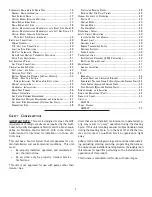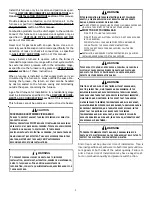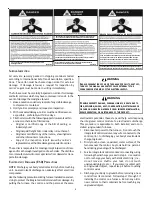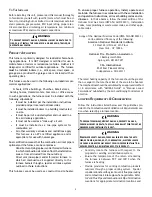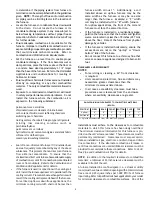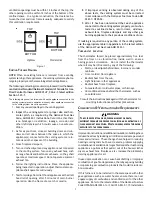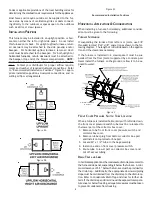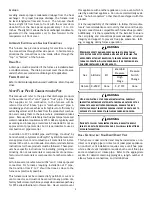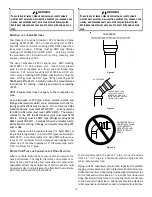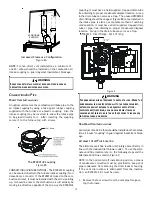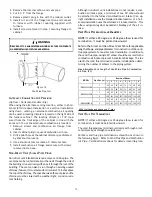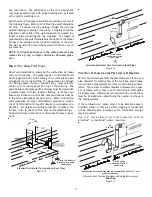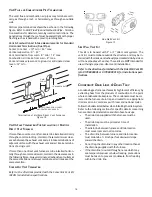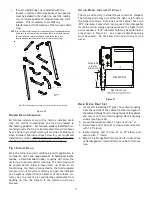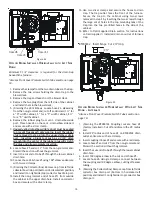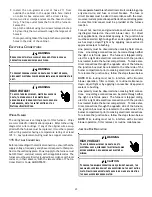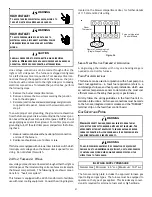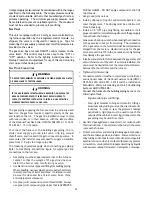
7
ventilation openings must be within 12 inches of the top; the
other opening must be within 12 inches of the bottom of the
confined space. In a typical construction, the clearance be-
tween the door and door frame is usually adequate to satisfy
this ventilation requirement.
TOP
BOTTOM
TOP
BOTTOM
Figure 1
E
XISTING
F
URNACE
R
EMOVAL
NOTE:
When an existing furnace is removed from a venting
system serving other appliances,
the venting system may be too
large to properly vent the remaining attached appliances.
The following vent testing procedure is reproduced from the
Ameri-
can National Standard/National Standard of Canada for Gas-
Fired Central Furnaces ANSI Z21.47, CSA-2.3 latest edition
Section 1.23.1.
The following steps shall be followed with each appliance connected to the
venting system placed in operation, while any other appliances connected
to the venting system are not in operation:
1. Seal any unused openings in the venting system.
2. Inspect the venting system for proper size and hori-
zontal pitch, as required by the National Fuel Gas
Code, ANSI Z223.1 instructions.
Determine that there
is no blockage or restriction, leakage, corrosion and
other deficiencies which could cause an unsafe con-
dition.
3. As far as practical, close all building doors and win-
dows and all doors between the space in which the
appliance(s) connected to the venting system are lo-
cated and other spaces of the building.
4. Close fireplace dampers.
5. Turn on clothes dryers and any appliance not connected
to the venting system. Turn on any exhaust fans, such
as range hoods and bathroom exhausts, so they shall
operate at maximum speed. Do not operate a summer
exhaust fan.
6. Follow the lighting instructions. Place the appliance
being inspected in operation. Adjust thermostat so ap-
pliance shall operate continuously.
7. Test for spillage from draft hood appliances at the draft
hood relief opening after 5 minutes of main burner
operation. Use the flame of a match or candle.
8. If improper venting is observed during any of the
above tests, the venting system must be corrected
in accordance with the National Fuel Gas Code ANSI
Z223.1/NFPA 54.
9. After it has been determined that each appliance
connected to the venting system properly vents when
tested as outlined above, return doors, windows,
exhaust fans, fireplace dampers and any other gas
burning appliance to their previous conditions of use.
If resizing is required on any portion of the venting system,
use the appropriate table in Appendix G in the latest edition
of the National Fuel Gas Code ANSI Z223.1.
T
HERMOSTAT
L
OCATION
The thermostat should be placed approximately five feet
from the floor on a vibration-free, inside wall in an area
having good air circulation. Do not install the thermostat
where it may be influenced by any of the following:
• Drafts, or dead spots behind doors, in corners, or under
cabinets.
• Hot or cold air from registers.
• Radiant heat from the sun.
• Light fixtures or other appliances.
• Radiant heat from a fireplace.
• Concealed hot or cold water pipes, or chimneys.
• Unconditioned areas behind the thermostat, such as
an outside wall.
Consult the instructions packaged with the thermostat for
mounting instructions and further precautions.
C
OMBUSTION
& V
ENTILATION
A
IR
R
EQUIREMENTS
T
O
AVOID
PROPERTY
DAMAGE
,
PERSONAL
INJURY
OR
DEATH
,
SUFFICIENT
FRESH
AIR
FOR
PROPER
COMBUSTION
AND
VENTILATION
OF
FLUE
GASES
MUST
BE
SUPPLIED
. M
OST
HOMES
REQUIRE
OUTSIDE
AIR
BE
SUPPLIED
INTO
THE
FURNACE
AREA
.
WARNING
Improved construction and additional insulation in buildings have
reduced heat loss by reducing air infiltration and escape around
doors and windows. These changes have helped in reducing
heating/cooling costs but have created a problem supplying
combustion and ventilation air for gas fired and other fuel burning
appliances. Appliances that pull air out of the house (clothes
dryers, exhaust fans, fireplaces, etc.) increase the problem by
starving appliances for air.
House depressurization can cause back drafting or improper
combustion of gas-fired appliances, thereby exposing building
occupants to gas combustion products that could include car-
bon monoxide.
If this furnace is to be installed in the same space with other
gas appliances, such as a water heater, ensure there is an ad-
equate supply of combustion and ventilation air for the other
appliances. Refer to the latest edition of the National Fuel Gas
Code NFPA 54/ANSI Z223.1 or CAN/CSA B149.1-15 Installation


